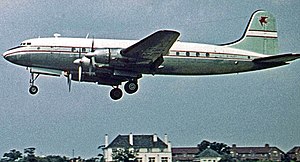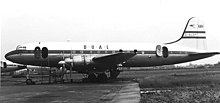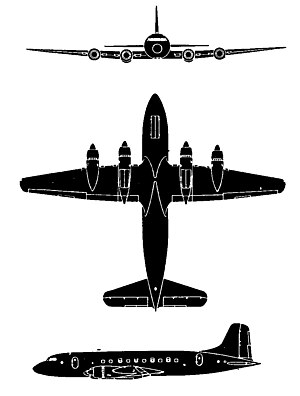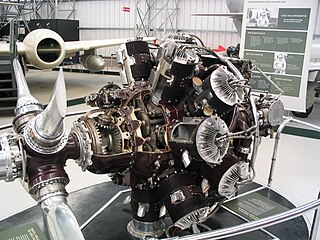
The Bristol Hercules is a 14-cylinder two-row radial aircraft engine designed by Sir Roy Fedden and produced by the Bristol Engine Company starting in 1939. It was the most numerous of their single sleeve valve designs, powering many aircraft in the mid-World War II timeframe.

Handley Page Limited was a British aerospace manufacturer. Founded by Frederick Handley Page in 1909, it was the United Kingdom's first publicly traded aircraft manufacturing company. It went into voluntary liquidation and ceased to exist in 1970. The company, based at Radlett Aerodrome in Hertfordshire, was noted for its pioneering role in aviation history and for producing heavy bombers and large airliners.

The Bristol Type 167 Brabazon was a large British piston-engined propeller-driven airliner designed by the Bristol Aeroplane Company to fly transatlantic routes between the UK and the United States. The type was named Brabazon after the Brabazon Committee and its chairman, Lord Brabazon of Tara, who had developed the specification to which the airliner was designed.

The Bristol Type 175 Britannia is a retired British medium-to-long-range airliner built by the Bristol Aeroplane Company in 1952 to fly across the Commonwealth. During development two prototypes were lost and the turboprop engines proved susceptible to inlet icing, which delayed entry into service while solutions were sought.

The Avro York was a British transport aircraft developed by Avro during the Second World War. The design was derived from the Avro Lancaster heavy bomber, several sections of the York and Lancaster being identical. Due to the importance of Lancaster production, York output proceeded slowly until 1944, after which a higher priority was placed upon transport aircraft.

The Handley Page HP.67 Hastings is a retired British troop-carrier and freight transport aircraft designed and manufactured by aviation company Handley Page for the Royal Air Force (RAF). Upon its introduction to service during September 1948, the Hastings was the largest transport plane ever designed for the service.
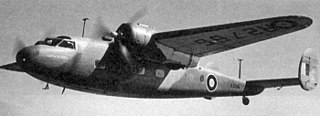
The de Havilland DH.95 Flamingo was a British twin-engined high-wing monoplane airliner first flown on 22 December 1938. During the Second World War some were used by the Royal Air Force (RAF) as a transport and general communications duties.

The Handley Page HP.137 Jetstream is a small twin-turboprop airliner, with a pressurised fuselage. The aircraft was designed to meet the requirements of the United States commuter and regional airline market. The design was later improved and built by British Aerospace as the BAe Jetstream 31 and BAe Jetstream 32, featuring different turboprop engines.

The Vickers VC.1 Viking is a British twin-engine short-range airliner derived from the Vickers Wellington bomber and built by Vickers-Armstrongs Limited at Brooklands near Weybridge in Surrey. After the Second World War, the Viking was an important airliner with British airlines, pending the development of turboprop aircraft like the Viscount. An experimental airframe was fitted with Rolls-Royce Nene turbojets and first flown in 1948 as the world's first pure jet transport aircraft. Military developments were the Vickers Valetta and the Vickers Varsity.

The Handley Page H.P.42 and H.P.45 were four-engine biplane airliners designed and manufactured by British aviation company Handley Page, based in Radlett, Hertfordshire. It held the distinction of being the largest airliner in regular use in the world upon the type's introduction in 1931.

The Short S.45 Seaford was a 1940s flying boat, designed as a long range maritime patrol bomber for RAF Coastal Command. It was developed from the Short S.25 Sunderland, and initially ordered as "Sunderland Mark IV".

The Short Solent is a passenger flying boat that was produced by Short Brothers in the late 1940s. It was developed from the Short Seaford, itself a development of the Short Sunderland military flying boat design.
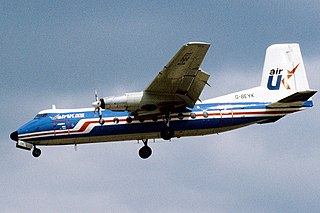
The Handley Page Dart Herald is a 1950s British turboprop passenger aircraft.

The Avro Type 688 Tudor was a British piston-engined airliner based on Avro's four-engine Lincoln bomber, itself a descendant of the famous Lancaster heavy bomber, and was Britain's first pressurised airliner. Customers saw the aircraft as little more than a pressurised DC-4, and few orders were forthcoming, important customers preferring to buy US aircraft. The tailwheel undercarriage layout was also dated and a disadvantage.

The Handley Page W.8, W.9 and W.10 were British two- and three-engine medium-range biplane airliners designed and built by Handley Page.

The Short S.26 G-class was a large transport flying boat designed and produced by the British aircraft manufacturer Short Brothers. It was designed to achieve a non-stop transatlantic capability, increasing the viability of long distant services/duties.

The Short L.17 Scylla was a British four-engined 39-seat biplane airliner designed and built by Short Brothers at the request of Imperial Airways to supplement the Handley Page H.P.42 fleet already in service after Handley Page quoted an excessive price for two additional H.P.42s. They were ordered in 1933.

The Handley Page (Reading) H.P.R.1 Marathon was a British four-engined civil transport aircraft, capable of seating up to 20 passengers. It was designed by Miles Aircraft Limited and largely manufactured by Handley Page (Reading) Limited at Woodley Aerodrome, Reading, England.
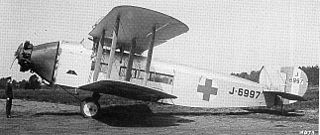
The Bristol Ten-seater and Bristol Brandon were British single-engine biplane transport aircraft built by the Bristol Aeroplane Company in the early 1920s. Only three were built, two of which were used as civil transports and one of which served with the Royal Air Force.
British Aviation Services Limited (Britavia) was an early post-World War II airline holding company and air transport operator that could trace its roots back to 1946. Its main activities included trooping, inclusive tour (IT) and worldwide passenger and freight charter services. British Aviation Services' first investment in a British independent airline occurred in 1946, when it acquired a minority interest in Silver City Airways. Silver City Airways operated the world's first cross-Channel air ferry service on 13 July 1948. It subsequently became British Aviation Services' biggest operating division. In 1953, British Aviation Services took over the independent airline Air Kruise. The same year, BAS Group also took control of Aquila Airways, the last commercial flying boat operator in the United Kingdom. The completion of these acquisitions by mid-1954 resulted in a reorganisation of the British Aviation Services group, with British Aviation Services Ltd (BAS Group) becoming the group's holding company and Britavia one of its operating subsidiaries. By the late 1950s, BAS Group became Britain's largest independent airline operator. Its numerous operating divisions included Britavia's Hermes Division at Blackbushe Airport and Aquila Airways's Flying Boat Division at Hamble near Southampton. The former concentrated on trooping services and inclusive tours while the latter provided scheduled services to Portugal, the Canary Islands and Italy. In 1962, BAS Group merged with British United Airways (BUA), which by that time had replaced BAS as the UK's largest independent airline operator.
